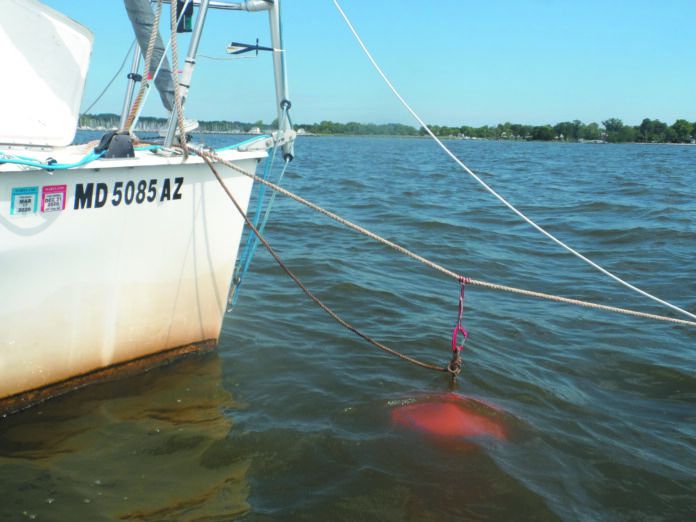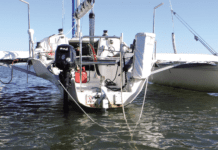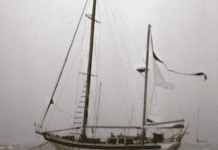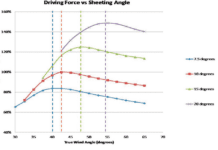Yawing is the result of imbalance between windage (you want it aft) and underwater resistance (you want it forward). If the center of windage is forward of the center of lateral resistance, the bow falls off and the boat sails off in an arc around the anchor, until forced to tack and return, the cycle repeating every few minutes. Fortunately, there are many things we can do to alter the balance or slow the cycling, and we tested a few last year (see “Rest Easy with a Riding Sail,” PS August 2019 and “Accessing the Anchor Kellet,” PS May 2019).
Riding Sails. Like the feathers on the back of an arrow, they keep the boat straight. The sail adds some drag, but this is much less that the wind drag of a yawing boat.
Hammer Lock Mooring. A second anchor is lowered on very short scope (1.2 to 1.5:1 scope) until it just drags, or maybe takes a light set. It is helpful to lower the anchor at the extreme of swing, but not vital, since the wind will change over time. A claw-type anchor is excellent in this application, most new generation anchors are good, and pivoting fluke anchors (Danforth-style, or Fortress) are poor. If the wind shifts and you have not moved in sync with the other boats, simply lift the anchor until the boat swings and then lower it again. Increasing hammerlock scope slightly in stronger winds will give it a better bite, but keep it well short of the primary anchor to avoid fouling of the anchors and twisting of the rodes in case the boat swings more than 180 degrees, as a result of tide or wind shifts. Do not use if there is grass or coral.
All-Chain Rode. Chain rode is always helpful. It reduces swing by dragging on the bottom and by reducing the effective length of the rode. However, once the wind picks up enough to lift most of the chain off the bottom it is less effective.
Kellet. Adding weight to the rode has a similar effect as an all-chain rode, but it is much lighter and thus somewhat less effective. It is a valuable aid to rope rodes, causing them to mimic the swing pattern of boat on all-chain rodes. A kellet made from a loop of chain is easier to handle than a lump of iron and won’t make a hole in the deck when you drop it.
Bridle. Although this does not alter the balance of the boat like a drogue on the bow or a riding sail, it helps bring the bow back to the center by providing a strong side force. It is very effective on multihulls (wide bow) and much less effective on monohulls (narrow bow).
Windage. There are the things that make yawing worse. A dinghy on the bow is the most common example. Reachers on bowsprits also contribute. Both act like riding sails at the wrong end.
Boards Up/Boards Down. With rudder down and the centerboard up, the bow quickly falls off and the boat sails all over the place. Some of the liveliest boats are centerboard/ dagger board types that lift the boards to prevent marine growth or reduce rattling in the case, but leave the rudders down. You can often pull just the rudder up with very little extra yawing.
We’ve used all of these methods to reduce yaw, each according to the situation. On a multihull, a bridle is the go-to method. For a monohull with a chain rode, a riding sail is generally the next step, or possibly a hammer lock, if you keep two anchors on the bow. With rope rode, a chain kellet is a good starting point. We keep the dinghy off the bow and lower the reacher if we expect a blow. We may anchor with the board up or down, but never with the board up and the rudder down. If the board goes up, the rudder goes up.
TECH GUIDE: YAW PREVENTION MEASURES COMPARED
| ANTI-YAW MEASURES | CENTER BOARD | RUDDER | SWING ANGLE | RODE TENSION AT 20 KNOTS | MULTIPLE OF WIND-ONLY LOAD ON RODE |
|---|---|---|---|---|---|
| NO BRIDLE | Up | Down | 135° | 170 lbs. | 2.83 |
| NO BRIDLE | Down | Up | 100° | 147 lbs. | 2.46 |
| DROGUES | |||||
| ROCKER STOPPER | Up | Down | 100° | 120 lbs. | 2.00 |
| ROCKER STOPPER | Down | Up | 90° | 110 lbs. | 1.83 |
| SEABRAKE GP24L | Up | Down | 90° | 110 lbs. | 1.83 |
| ROCKER STOPPER | Down | Up | 80° | 100 lbs. | 1.67 |
| OTHER METHODS | |||||
| RIDING SAIL (FIN DELTA) | Down | Up | 42° | 106 lbs. | 1.77 |
| HAMMER LOCK MOORING | Down | Up | 35° | 90 lbs. | 1.50 |
| CHAIN RODE | Down | Up | 85° | 135 lbs. | 2.25 |
| 10-POUND KELLET | Down | Up | 80° | 131 lbs. | 2.18 |
| BRIDLE (2:1 LEG/BEAM, DYNEEMA) | Up | Down | 40° | 95 lbs. | 1.58 |
| BRIDLE (2:1 LEG/BEAM, DYNEEMA) | Down | Up | 12° | 67 lbs. | 1.12 |







































